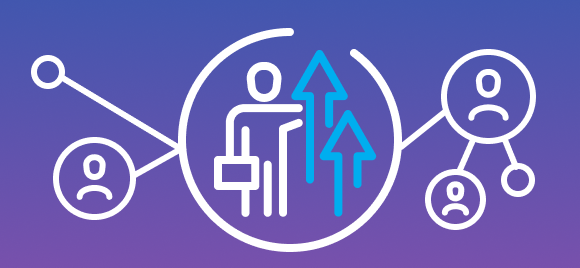Disparate data sources, metrics, and reporting timelines are barriers to making data-driven decisions. Learn how to change it.
Continue readingHiring Marketplaces – A Sustainable Approach to Hiring
When it comes to staffing suppliers, more is more – the bigger your supply base, the better your access to quality talent. Achieve an exponential ability to hire using a hiring marketplace powered with the latest technology to facilitate the end-to-end management of your contingent workforce program.
Despite the benefits, having a large staffing vendor list isn’t always the preferred choice for hiring businesses. Usually, businesses try to manage their supplier relationships by ‘optimizing’ (i.e., cutting down on) their supply base and partnering with a few ‘trusted’ suppliers. But often this strategy is backed by perception rather than factual data. Here are some things to consider when thinking about your supplier list:
Are there any consequences to my supply base’s shifting capabilities?
Just as concentrating your investment portfolio subjects you to more risk and volatility, depending on a few suppliers to fulfill your contingent hiring needs can jeopardize the success of your external workforce program.
Changes in supplier capabilities are increasingly common because the staffing industry is extremely volatile and suffers from a high turnover rate. Just like a concentrated investment portfolio can expose you to downside risk, operating with a restricted vendor list can increase the likelihood of facing hiring delays or compromises in candidate quality if one or more of your vendors is experiencing turnover or volatility.
The solution here, in both investments and contingent hiring, is diversification. A diversified ‘portfolio’ of suppliers minimizes volatility, decreasing the likelihood of a dip in performance across the whole based on changes in a few vendors, and ensures a smooth-running contingent program supplied with quality talent.
Are my talent suppliers delivering consistent high performance?
Knowing the current price of a stock is imperative for investors looking to buy or sell. In a rapidly rising or falling market, relying on delayed stock quotes is virtually useless since the stock could have moved by a significant percentage in that time frame.
In the same way, depending on quarterly performance data to evaluate your talent suppliers doesn’t shield your business from the dynamic nature of staffing organizations, increasing your risk of engaging with poorly performing suppliers. This can lead to a continuous cycle of onboarding and offboarding suppliers.
In short, backward-looking data governing supplier performance does not give you a continuous performance guarantee and can lead to losses in time, money, and valuable resources.
Can my supplier pool effectively and efficiently support hiring at scale?
Having a limited supply base limits your reach across niches, geographies, and talent pools.
In situations of rapid growth where you need to meet unanticipated hiring demands, a lean vendor list may not be able to deliver at pace or meet the desired quality. When you fill these gaps by sourcing, vetting, and onboarding new staffing firms, you consume time and delay your ability to utilize talent from your contingent workforce program.
The Power of the Network Effect over Traditional Hiring:
The internet has made it easier to bring crowds together, leading to groundbreaking innovations over the past decade. Businesses see crowds as innovation partners and humans are increasingly depending on the wisdom of crowds — whether it’s deciding the next Netflix binge or obtaining live traffic updates.
Likewise, the ‘human cloud’ is shaping the future of staffing by providing businesses with new and innovative ways to automate their connection to talent. Human cloud platforms serve as an attractive and inexpensive means of accessing contingent workers, as businesses prioritize resilience and efficiency during these uncertain times.
These modern hiring platforms are built on crowd-based networks of independent and international recruiters, boutique, national, and regional firms, along with the respective talent pools they represent. As opposed to traditional hiring solutions, human cloud platforms can span across cultures, geographies, business sectors, and ideologies, amplifying businesses’ reach over skilled talent at reduced costs.
Human cloud platforms are becoming sought-after ‘talent suppliers’ in today’s technology-fueled gig economy. During 2019, these platforms reportedly grew by ~15% and are expected to continue rising in demand as workers laid off due to the COVID-19 pandemic pursue new opportunities.
Secure Your Future by Taking a Marketplace Approach to Hiring:
From retail to transportation to entertainment, the marketplace model has profoundly altered almost every industry. Consider how Amazon’s retail revolution is changing the way we shop or how Netflix is transforming our entertainment purchase and consumption.
In the same way, hiring marketplaces are re-shaping the future of staffing. How?
Disruption through centralization:
Just like Amazon acts as a centralized hub for third-party vendors with similar offerings, hiring marketplaces unify the fragmented staffing world by bringing businesses, staffing agencies, independent recruiters, and candidates together on a common digital platform. Unlike traditional hiring models, businesses needn’t navigate through disjointed sources, including multiple staffing suppliers, social media, job boards, and internal talent pools, to find the right candidates.
Personalization:
Another reason for the success of marketplaces is personalization. Netflix has perfected the secret formula to customer-experience using smart AI algorithms to interpret data. Similarly, intelligent hiring marketplaces are highly cognizant of business’s talent needs. They automatically match jobs to the most qualified candidates and vendors within the ecosystem and facilitate better user and candidate experience in addition to boosting overall hiring outcomes.
As the pandemic is accelerating the trend towards contingent hiring, early adopters of these hiring ecosystems end up gaining a competitive advantage. How? By shifting their investments from performing routine and repetitive work to encouraging their internal talent acquisition teams towards strategic thinking and decision making.
What Makes The Crowdstaffing Hiring Marketplace Different?
The Crowdstaffing Hiring Marketplace combines machine, network, and human intelligence to deliver businesses the best hiring outcomes. Our hiring marketplace consists of a vetted and diverse list of talent suppliers, guaranteeing you access to the best talent in the market.
Real-time performance metrics constantly monitor suppliers on our platform and our smart algorithms automatically match your job descriptions to the best-performing vendors with the most qualified talent.
Forget lengthy implementations and extensive onboarding timelines; suppliers can join our platform by completing a simple registration form and start recruiting in 30 minutes. We also ensure 100% compliance by serving as the Employer of Record, offloading most of the employee management complexities from suppliers.
To top it all, our cost-neutral plug-and-play hiring solution comes with absolutely no initiation costs.
Sound interesting? Post a job on our hiring marketplace now!
How to Move Forward from Backfilling Jobs
The latest jobs report from the Bureau of Labor Statistics (BLS) tells a story of stasis and small improvements. The good news is that businesses hired 5.3 million professionals. The not-so-amazing news is that all industries, in aggregate, witnessed labor turnover rates to the tune of 5.1 million workers. The 0.2 percent difference would indicate that just as many people left their positions as came aboard. Other sources, such as Compensation Force, depict employee attrition rates close to 17 percent, based on a survey of 28,000 companies. That’s the highest level of churn since 2008, the dawn of the recession. What happens when turnover spikes? Organizations scramble to backfill positions, oftentimes creating opportunities for staffing providers. However, backfilling is usually a short-term fix for what can be a longer-term issue. Instead of backfilling, let’s see how progressive filling can innovate a fresh approach to a stale situation.
In Through the Out Door
With fierce competition for skilled workers, retention and performance are big concerns for employers. Even in contingent labor programs, it’s imperative that workers remain committed to the mission, see their assignments through and deliver high-caliber, on-time results. Findings by Impact Instruction Group reveal just how pronounced the issue of turnover has become.
- Nearly one-third of people employed in their current job for less than six months are already searching for new career opportunities or employers.
- Close to one-third of executives who join organizations as external hires fail to achieve expectations during their first two years on a new job.
- With annual attrition rates of 10 percent to 15 percent, companies are turning over almost 60 percent of their entire talent base within four years.
Retention has taken its place as one of the most important topics in the future of talent. There’s an even more pressing problem, however. Too many companies keep underperforming or mediocre talent, which hobbles their growth. Many rationalizations spring to mind: the workers are loyal, they have niche skills that would be hard to replicate, budgets are tight, recruiting takes too much time, and so forth. In the end, many leaders settle on the compromise that an occupied desk is better than an empty one.
Yet continuing to rely on recruitment methods like backfilling, won’t necessarily satisfy the needs of organizations in the fast-paced digital world. That’s why we need to examine an alternative approach to keeping businesses competitive, dynamic, inventive, and pushing ahead.
Challenges with Backfilling
What is backfilling? In employment law, it’s the practice of replacing a departing worker as quickly as possible, regardless of whether the former individual left the company or simply moved into another position. The hope is to retain the same headcount with minimal disruption. In our industry, backfilling is more commonly used to replace a regular member of a corporate team during a long absence — planned or unplanned. In days past, the process was straightforward and relatively easy to accomplish. The mechanisms of commerce, production, and service delivery in this century have contributed to new challenges.
Successful backfilling involves identifying positions with no redundancy and establishing sources to replace talent before a dire need arises. Our current economy, however, runs lean and mean. Very few positions offer inherent redundancy. And that creates hurdles.
- In desperate times, management-level resources must step down into the trenches to sustain the momentum of the operation. This tactic, unfortunately, causes a leadership deficit during the interval, which can produce new obstacles or adverse impacts.
- Cross-training and ongoing development programs can prove effective in building an agile workforce populated by talent who become poised to assume new roles if a position suddenly vacates. Yet, workforce development, despite its popularity as a concept, lags behind in actual implementation or practice. Many organizations cite the costs and time involved as impediments.
- A growing majority of businesses and MSPs turn to staffing professionals. This is generally a fast and efficient solution. However, complications occur when hiring managers fail to communicate concerns, at-risk positions, or anticipated demands to their MSPs or staffing partners.
Making Business Progress Through Progressive Filling
Writing for ERE, organizational development expert Brian Formato explored how business cultures find themselves in periods of stagnation and why backfilling may not resurrect their productivity. He opens the piece with a well-known quote by Steve Jobs: “A players hire A players and B players hire C players.” Yet too many business leaders remain content to shuffle along with underperforming teams — until the crisis reaches a head and drastic steps become necessary.
“The typical approach that leaders take is to let the problem fester until it becomes too late,” Formato says. “At that point they are forced to take action and terminate the underperformer, creating a hole with no clear succession plan.”
It’s at this juncture where companies frantically work to backfill the positions. Unfortunately, this late-in-the-game effort can lead to losses in time, productivity and revenue. That’s why we need to propose a modern twist on backfilling — a proactive method of progressive filling.
Formato questions why we don’t use the same mindset with underperforming workers as we do with underperforming appliances. Think about it. If your computer is still running an operating system from seven years ago, you’re suffering. Programs take too long to load. They crash. The machine’s available memory can no longer handle the demands of current business tools. It’s become unreliable, unpredictable, and incapable of taking you to the next level of your work. So what happens next?
You see an ad for new computers. They’re sleek, top-of-the-line performers that are already configured to address your existing and future requirements. You go online, research the options within your price range, narrow down the best fits and prepare to make a purchase. Ultimately, you’ve convinced yourself that you need a new model before the old one finally fails. This is where progressive filling takes the reins.
Identify Potential Performance Issues
“If you have an underperformer on your team, the best way to upgrade the position is to identify the replacement first,” Formato suggests. One of the core tenets behind Six Sigma is to seek out and identify defects in the process continually. It’s less pleasant than hoping or pretending that everything in the organization is hunky dory, yet it’s necessary for finely tuned operations. When you proactively spot pitfalls looming on the horizon, you can quickly forecast new needs — with the luxury of time.
Proactive Sourcing
Even with no open requisitions, the best recruiters are always sourcing for top talent in the positions they support for clients. They understand the unforeseen peaks and valleys that accompany talent acquisition. For instance, if a staffing provider supports a company that thrives because of software development, that agency is constantly sourcing for the best and brightest in the field. When needs are identified, these staffing curators are already prepared to offer a superior candidate.
Passive Recruiting
Formato, as many industry experts, recognizes that passive job seekers often become the best employees. On average, staffing providers spend 80- to 90-percent of their efforts developing networks and courting passive talent. Corporate teams, conversely, often have time enough only to source active candidates.
Engaging staffing professionals can help. They are adept at creating performance profiles that define and sell the job – its rewards, opportunities, and challenges. They partner with clients to gain a comprehensive understanding of the role: how it relates to the work, how it fits the organization’s culture, how it can shape sourcing initiatives, and how it will encourage the right candidates to apply.
They also know how to reach passive candidates by targeting communications to their audience using emails, social media, newsletters, career sites, and other resources. Active seekers on job boards and recruitment platforms represent about 25 percent of the prospective talent pool. That means efficient staffing providers are accessing an additional 75 percent.
Why Move Back When You Can Push Forward?
There is no crystal ball that enables us to predict the future. With unprecedented speed, industries are changing, companies are changing, the nature of work is changing, and our very roles in society are changing. The reality is that we don’t need a crystal ball. The solution is to keep our eyes open, study performance data, actively look for areas of improvement, and then act progressively. Engaging innovative staffing professionals won’t just help you see the forest for the trees — it will allow you to plant the seeds of a stronger crop before a drought hits.
In Staffing The Right to Represent Should Be Digital
Hiring is hard. Hiring at scale is even harder. That’s where hiring technology comes in. Our Vendor Management System (VMS) simplifies how companies manage their contingent hiring programs.
You’re sourcing for an open position — let’s say you’ve asked your staffing vendors to source viable candidates for a contract sales position in Chicago, IL. Recruiters and agencies are scouring talent pools, combing LinkedIn, and actively reaching out to anyone they think would be a good fit. But, they’re all going after the same talent, and while Chicago is a big city, there’s still a limited pool of candidates who are qualified and seeking work.
Your staffing vendors come across candidates who seem like a perfect fit for the position. They have the right experience, they’re looking for new opportunities, and they’re available for contract work. To ensure they get credit for (i.e. get paid for) their candidates, these recruiters want you to know which ones they’ve submitted, especially if other recruiters are trying to submit the same people. And, you don’t want a list of candidates with duplicate submissions from different staffing agencies.
Enter: The right to represent, an agreement between a recruiter and a candidate in which the candidate allows just that recruiter to submit their application. How is ours different? It’s completely digital, lives within our vendor management system (VMS), and is required of every submitted candidate for every open job.
Traditional right-to-represent forms come in all different varieties — some are only for that specific position, others are more encompassing, and most are somewhere in the middle. Typically, these forms are signed on paper and uploaded to VMSs, leaving plenty of room for duplicate submissions and other errors. For instance, how do you know when the candidate signed it—or if it was them who actually signed it? What happens if multiple recruiters claim that the same candidate signed a right to represent with them?
Things can get hairy—and quick. That’s why we think the right to represent should be done digitally and for every position a candidate is submitted for. Not only does it solve the problem of recruiters not being rewarded for the hire, but it also eliminates duplicate submissions, and allows the candidates to choose the recruiter that represents them.
Why Digital is Best
Traditional VMSs use a “first in” approach when it comes to scanning right to represent forms. This puts the pressure on recruitment agencies to submit candidates as quickly as possible, sometimes resulting in recruiters who forge the signature in order to submit a candidate first.
Gives Candidates More Say in Their Job Search
Crowdstaffing VMS uses a different approach. By making the entire right to represent process digital, it records time stamps and IP addresses which makes it nearly impossible for a candidate to be misrepresented or represented multiple times. In this way, we put the candidate first, ensuring that they are in charge of their own job hunt and that they want to be represented by this agency for this job.
Prevents Duplicate Submissions
It also saves our clients time and effort by preventing each candidates’ application from being submitted by multiple agencies, which clutters the list of viable candidates with duplicates. And, if a hiring organization is interested in a candidate with duplicate submissions, they may have a hard time determining which recruiter sourced them first. In our system, candidates can only be submitted once, so our clients get a list of quality candidates without duplicates.
How Our Digital Right to Represent Process Works
In Crowdstaffing VMS, a recruiter invites a qualified candidate to apply for the open job. The candidate then logs into our platform to declare whether they’re interested and, if so, whether they want to be represented by the recruiter who invited them to apply. If multiple recruiters invite them, candidates are prompted to choose within our system which recruiter they would like to go with.
Once a candidate has accepted an invitation to be submitted for an open position, they digitally grant their recruiter the right to represent. Because we’ve made this a required step in the sourcing process, there’s never confusion around which recruiter represents each candidate: a win-win-win. Candidates have full control over whom they work with and for which jobs they’re submitted. Recruiters don’t waste their time pursuing candidates who are already submitted. Hiring companies no longer have to battle with recruiters over who submitted a candidate or work from a list that includes duplicate candidates.
Interested in seeing how this works in action?
How Marketing Buyer Personas Can Help Recruiters Build Amazing Talent Pools
As today’s workforce evolves, the role of recruiters is becoming even more pivotal. Candidates aren’t attracted, sourced and recruited the same way they were a decade ago. The transactional tactics of matching skills, work experience and compensation to job descriptions no longer bear the same fruits. As the industry moves toward predictive analytics, digital ecosystems and on-demand talent pools, the best recruiters are confronted with the challenges of casting wide yet targeted nets. And the question becomes: where do they find the right talent, and who are those candidates? We wrote recently that the most effective sourcing processes are beginning to mirror business development and marketing mindsets. By borrowing a page from the inbound marketing playbook, we can retool the notion of buyer personas to create talent personas that uncover the top candidates we need — for any client.
Connecting the Dots in the Hiring Ecosystem
One of the most significant shifts in the staffing industry has dawned from the explosive growth of the “human cloud,” an expanding ecosystem populated by a crowd of contractors, consultants, freelancers and subject matter experts who are seeking new models of employment. This ecosystem drives the gig economy and has altered the way we think about talent acquisition. In fact, it was one of the most widely heard phrases in discussions in the industry. According to a report by Staffing Industry Analysts (SIA), the revenue generated by Human Cloud platforms has risen by 42% in 2019 amounting to $178.5 billion. The concept of a crowd-based hiring ecosystem, connected by digital intelligence and new recruiting strategies, is something we’ve talked about for years.
With the rise, and tremendous benefits of HR ecosystems, recruiters must also learn to approach talent acquisition differently. Today’s marketplaces, fueled by the gig economy, demand immediacy, fluidity, elasticity and an on-demand structure. Accommodating these new needs can be difficult, especially when clients expect the same door-to-door type service they receive from gig pioneers like Uber. Building virtual talent pools is becoming imperative. ADP predicted in 2016 as follows:
Waiting until job descriptions or salary ranges are finalized before making overtures of interest can impact success rates, especially if other organizations beat you to the punch. So developing a pipeline of potential candidates and hinting that a position will be available soon makes it possible to improve your chances of overall hiring success.
So how do we find the workers we need? That’s where marketing personas could emerge as powerful arrows in the modern recruiter’s quiver.
Recruiting through inbound channels has changed the hiring landscape dramatically. In fact, it’s improved the way candidates learn about recruiters, connect with them and interact with them. Where outbound marketing often requires buying ads, building email lists and hoping for leads, inbound marketing focuses on the creation of quality content that pulls candidates toward your organization — it explains to talent why they’ll want to be a part of your team. The secret lies in aligning the content you publish with the interests of candidates. When done right, this creates an inward flow that naturally attracts prospects who can be converted, hired and delighted over time.
Understanding the Concept: What is a Buyer Persona?
As marketing leader HubSpot explains, “Buyer personas (sometimes referred to as marketing personas) are fictional, generalized representations of your ideal customers. Personas help us all — in marketing, sales, product, and services — internalize the ideal customer we’re trying to attract, and relate to our customers as real humans. Having a deep understanding of your buyer persona(s) is critical to driving content creation, product development, sales follow up, and really anything that relates to customer acquisition and retention.”
The most powerful buyer personas are based on market research and insights gathered from customer interactions, surveys and other communications. They empower a greater understanding of customers, as well as prospective customers, in marketing organizations. This makes it easier for them to tailor content to the specific needs, behaviors, motivators and concerns of different groups. So instead of sending everyone in the database the same messaging, buyers can be segmented and matched to specific pieces of content that are the most appropriate and appealing to their needs.
If you follow the logic of buyer personas, you should begin to realize how relevant they would be for recruiters who are pursuing top candidates.
How to Build Talent Personas
Define the Business Culture
The first step in building talent personas is defining the culture of your staffing organization and the culture of each client you support. To paraphrase Sedef Buyukataman’s article in TLNT, you must take a “broad and unbiased view.”
“Leave bureaucracy and politics to one side, and look at your internal workflows and functions in relation to your market perception and goals,” Buyukataman writes. “Each persona is built from multiple internal and external data sources then compiled into a matrix of skills, aggregate trends in ‘ideal’ employee behaviors and attributes, and market research aligned to your company growth plans.”
“Thanks to HR technology platforms,” she adds, “we also have access to various dimensions of historical data on hiring success, employee performance, development, and turnover. Accessing data from online channels like your website or LinkedIn will enhance your traditional salary/market/industry research as well. Use what you have to build as focused a picture as you can.”
Document all the information you gather during phone interviews and social media interactions. Check out the LinkedIn connections of your candidates, and use all of this data to spot trends. Now, it’s time to flesh out the profile. The basic structure of your talent persona will be four sections with specific categories that address the fundamentals of Who, What, Why and How.
Section One: Who is Your Candidate?
For the first section of your talent persona, you want to list out critical details of the candidate’s background, demographics and identifying characteristics or behaviors.
Background
- Predominant job titles or roles.
- Level of education and majors.
- Skill sets.
- Relevant background data, such as educational level, hobbies, etc.
- Industries they have supported, excelled in or prefer.
- Size and type of the organizations they have worked in.
- What have the persona’s responsibilities typically included?
- How does the persona gain new information (e.g., online courses, conferences, etc.)?
- What publications or blogs does the persona read?
- What associations or social networks does the persona belong to?
- How does the persona prefer to communicate and interact with recruiters (e.g., email, social media, phone, SMS, face-to-face, etc.)?
- What are the primary tools or methods the persona uses to find job opportunities (e.g., job boards, online recruitment platforms, LinkedIn, etc.)?
Demographics
- Years of experience in the job market or in a certain function
- Salary history.
- Location: is the persona rural, urban, or suburban?
- Level in career path (e.g., entry level, returning to workforce, alumni, senior management, changing careers, etc.).
Identifiers
- Buzzwords that the talent uses or responds to.
- Mannerisms: how would you characterize the overall demeanor, attitude or behavior of the persona based on your interactions?
- How does the persona prefer to communicate? By phone, email, text, or other medium?
Section Two: What Motivates Your Candidate?
Goals
- Describe the persona’s primary career goal, aspiration or inspiration.
- Now, try list out the persona’s secondary goals or motivators.
Challenges
- What are the primary challenges the persona has encountered in his or her job searches?
- What are the secondary challenges this individual has faced?
- Do they differ based on job, industry or employer?
How Can You Help?
- How can you help solve the persona’s challenges in finding a great position?
- How can you help the persona achieve his or her goals?
Section Three: Why Has the Candidate Succeed or Faltered?
Real Quotes
During your conversations or correspondence with candidates, jot down a few actual quotes that represent the talent persona well. This will also help you establish veracity, create compelling messaging for similar profiles, and make the persona relatable to a wider audience.
Common Objections
- Identify the most common objections the persona might raise during the hiring process.
- Examples could include: “I’m afraid I’ll have to relocate,” “I worry about access to skills development and a real career path,” or “I want the flexibility to work remotely on occasion.”
Section Four: How Will You Communicate the Right Story to Similar Talent Personas?
Marketing Message
For each type of talent persona, you want to take all the intelligence you’ve collected and synthesize that information into a compelling message.
- What solutions can I offer this persona?
- How should I describe the solution to this persona?
- What message will the persona see as the most meaningful?
- What are the best media to reach candidates who fit this talent persona: blogs, tweets, InMail, Instagram, Facebook, phone calls, emails, or others?
Elevator Pitch
An elevator pitch is a succinct and persuasive sales message used by business development professionals. The idea is to come up with an engaging or intriguing pitch that explains a product or service and its value — in the amount of time it would take to ride an elevator. Recruitment marketers should develop a similarly punchy and powerful statement to describe their solutions, in a manner that’s direct, simple and consistent for each talent persona.
The Audience is Listening -- Make Sure Your Voice is Heard
More than ever, it’s crucial that your recruitment message makes its way to the appropriate audience. If staffing professionals want to ensure that they’re reaching the right candidates with the right skills for the right clients, developing targeted talent personas can make all the difference.
The Best Recruiting Metrics to Measure Your Staffing Vendors’ Success
Season after season, fans eagerly await the imminent return of professional baseball. And part of their excitement no doubt stems from the numbers they avidly follow: runs batted in (RBIs), batting averages, earned run averages (ERAs), strikeouts, steals, home runs, win-loss percentages, and many more. In the major leagues, numbers track every element of the old ball game. Indeed, nowhere else in sports are statistics more important than they are in the great American pastime.
Fielding a winning baseball team requires managers and coaches to track some pretty arcane numbers. The same holds true when you’re building your own winning team in just about any business or industry—whether you source your players from:
- Recruiting firms. In our baseball analogy, these would be the college and minor league teams that feed talent to the big leagues.
- Seasoned headhunters. Pro baseball teams call them “scouts.”
- Your own self-generated talent pool, finding heavy hitters in the “free agents” who apply for your open positions independently.
However (and wherever) you find talent, you need to track Key Performance Indicators (KPIs) to determine how successful each of those efforts are, helping you determine the best possible staffing resources for the roles you need to fill.
Q&A: Staffing KPIs That Best Track Staffing Vendor Performance
To help shed some light on which KPIs may be the most important to track and learn from, we’ve spoken with Casey Enstrom, Prosperix’s VP of Enterprise Solutions, who has spent nearly 20 years in the staffing industry and specializes in sales and operations.
Question: What are the most common hiring KPIs to track staffing vendor performance?
KPIs are critical in providing insight into supplier performance, maintaining a clear understanding of expected outcomes, and driving focus in the right areas—all of which positively influence performance. I would say that the most commonly tracked KPIs in staffing are:
- Submissions to Positions
- Time to Submit
- Submissions to Interview
- Submissions to Hire
- Interviews to Hire
- Time to Hire (from when a job is published to the start date of the person hired)
- Assignment Completion
Question: Which of those KPIs do you feel are the most important and why?
In my experience, Submissions to Positions, Submissions to Interview, Submissions to Hire, and Assignment Completion are most helpful in determining the performance and value of staffing partners. These KPIs measure each staffing supplier’s responsiveness, whether they source an appropriate number of candidates, the quality of those candidates related to open positions, and whether they source reliable hires who successfully complete their assignments. Any staffing vendor that does those well is a worthy partner.
Question: Are any commonly tracked KPIs actually unhelpful or distracting?
This can be a hard question to answer—or at least one that is subject to opinion. In general, I feel all data is important and should be leveraged to provide a complete and comprehensive picture of supplier performance. That said, I’ve been involved in many programs where clients used Time to Submit alongside the total number of submittals as their primary metrics to rank supplier performance. Neither of these speak to candidate quality or candidate experience.
In fact, when these two KPIs are given undue attention, many programs become inundated with too many submittals. This not only results in unnecessary work on the part of the client when it comes to sifting through submissions, but also risks burying the best candidates. What happens is that these KPIs essentially train staffing suppliers to submit as many candidates as possible and as quickly as possible, without time and attention spent on skill- and culture-fit. When overwhelmed with too large a quantity of candidates, clients often only review the “top of the stack” from the candidates submitted, leaving the perception of a “resume black hole” for many candidates and a poor candidate experience. Plus, when hiring programs like these don’t include shortlisting or curation services, then there is inherent risk that a “best fit” candidate will be missed.
Question: How often should organizations review their staffing vendors’ KPIs?
In today’s world, most businesses review their hiring program’s KPIs on a quarterly basis. While this is better than nothing, I struggle to understand how real-time KPI review is not at all a common practice for most contingent workforce programs—especially when technology that offers real-time data is so readily available.
Dashboards showing live KPI performance for a client’s supply base can and should be available to maintain an optimal contingent workforce program. And I’m not just referring to a stack rank of staffing vendors or even each vendor’s YTD performance by KPI. I argue that hiring programs would benefit from reviewing each vendor’s KPI performance in real-time, down to a requisition when that makes sense.
This is part of how we at Prosperix are challenging the industry status quo. To us, working with static staffing supplier lists and traditional tier-based job distribution to those suppliers are rudimentary and archaic. That’s why we’ve developed a solution that provides our client users with a dynamic and real-time approach to leverage the best suppliers—at that given time and for that given role, based on each supplier’s active talent pool and bandwidth at that moment.
In my experience, maintaining a dynamic and agile approach to KPIs will greatly improve and enhance any contingent workforce program by ensuring constant knowledge, iteration and innovation. In the end, this is all about how to swiftly identify the best talent to join and benefit your company. It shouldn’t just be about who can provide the most bodies.
Question: In what way(s) does Prosperix allow client users to track KPIs?
Our strategy is to track everything, so that everything can be reportable. Unique to our approach, and what many of our clients love about it, is our ability to present data across the entire recruiting workflow. This provides visibility into supplier performance from the beginning of the process (e.g. number of candidates currently sourced, number currently being screened, etc.). Traditional MSP/VMS solutions don’t typically offer that calibre of reporting. They can generally track agency performance only after candidates are presented.
Other unique KPIs we track are specific to each staffing vendor’s Candidate Experience. In my opinion, to ensure the best staffing suppliers are a part of your contingent workforce program, you need to capture the voice of their candidates during the entire recruiting process.
Yet another measurement element that’s hardly tracked revolves around KPIs that focus on innovation, market intelligence, or any value-added elements that clients should receive from their staffing vendors. Most staffing partners claim to act as an extension of their client, but how much are they really doing to assist their clients’ growth, knowledge, or adoption of innovative opportunities that improve their hiring strategies? To me, this form of KPI—or accountability to program enhancements, improved efficiencies, and knowledge building—could be significantly more impactful than the number of candidates presented on average for any given position.
A Vendor Management System that gives you the insights you need to win
Prosperix VMS Network works relevant KPI metrics into a dynamic scorecard to help your team come out ahead of the game both now and in the long term. You can run these reports at will or schedule them to arrive regularly—whatever you find most helpful. Plus, the system uses that data to automatically send your job requisitions to the best suppliers for each role at that time, thanks to dynamic tiering made possible by our groundbreaking artificial intelligence.
Want to know more? Here’s our pitch: Get a demo of Prosperix VMS Network to see how you can customize your supplier scorecard and use it to make more informed decisions. Step up to the plate and contact us today!
Why Does A Staffing Vendor Management System Make Sense For Growing Businesses?
Contingent work is becoming increasingly popular among individuals and businesses, with more than one-third of the U.S workforce comprising contingent workers. As the use of the contingent workforce continues to accelerate, businesses are developing contingent workforce programs backed by Vendor Management Systems.
What is a Vendor Management System (or VMS)?
A Vendor Management System is a web-based/cloud based application that governs the procurement and management of a business’ contingent workforce. Using a VMS, businesses can facilitate the end-to-end management of the contingent talent lifecycle from the creation of job requisitions, through candidate sourcing, onboarding, contracting, invoicing, and payment. In addition to automating the contingent workforce management processes, the Vendor Management System acts as a common touchpoint by streamlining communication between businesses, staffing suppliers and Managed Service Providers (MSPs).
Why Contingent Workforce Programs Perform Better with Vendor Management Systems
The lack of standard processes surrounding a business’ contingent workforce management makes implementing and governing a contingent workforce program an arduous task. A 2020 study performed by the Everest Group found that a large number of businesses are behind in developing efficient vendor management processes where staffing suppliers are well managed. To have a swift and efficient supplier selection and management process, investing in a vendor management system (VMS) is imperative — here’s why.
Reduce supplier onboarding timelines:
Without a vendor management system to govern both supplier and candidate data, information often gets scattered across multiple departments in systems that don’t necessarily speak to each other. By using the right vendor management software, businesses are able to retain all the data on a single system. This makes your supplier approval process easier and speeds up supplier onboarding. Additionally, when data resides on a single system, you can avoid inconsistencies in the onboarding process thus shielding your business from legal and compliance risks.
Optimize supplier performance:
Without a vendor management system in place, evaluating supplier performance becomes more difficult; when supplier reviews are done on an infrequent basis, you risk the success of your contingent workforce programs inadvertently jeopardizing your business down the road.
Automate processes:
Manually managing the various vendor management processes like supplier onboarding, contracting, invoicing, vendor performance, etc., disrupts workflows, hinders communication between teams, and slows down your operating speed. In the case of a hiring ramp-up requiring the rapid expansion of your supplier base, the lack of a centralized vendor management system causes your back-office teams to be burdened with data influxes. VMS solutions allow you to automate the entire contingent workforce management process and provide your in office teams data at their fingertips in one easy-to-use solution.
Eliminate rogue spend:
By using a VMS solution, businesses can keep their finances up-to-date by precisely tracking program spend. Having an increased visibility over your contingent workforce programs allows you to identify and analyze the occurrence of rogue spend. By implementing a comprehensive VMS solution, you are able to assess fair market rates in addition to ensuring vendor compliance.
Plan your talent strategy using advanced reporting and analytics:
VMS solutions with advanced data analytics allow you to monitor candidates at every stage of the hiring pipeline — driving candidate visibility, increasing engagement, and equipping you with data insights on your suppliers’ activity. This allows you to initiate a long term talent strategy and enable better enterprise-wide decision-making.
What Makes Prosperix VMS different from other Vendor Management Systems?
Now that we’ve covered some of the value propositions of the VMS as a concept, here are some ways that Prosperix VMS is differentiated from the rest of the Vendor Management offerings on the market:
Fully Integrated Hiring Marketplace:
A VMS solution with a fully integrated hiring marketplace like the Prosperix VMS allows you to start hiring immediately. Using a hiring marketplace, you can manage your existing talent suppliers, as well as access a growing network of thousands of motivated talent suppliers representing every skill, niche and geography. Our built-in supplier network provides democratized access to more talent pools, better coverage and higher-quality candidates so you can quickly fill your open positions.
Real-Time Reporting & Analytics:
A VMS solution with a fully integrated hiring marketplace like the Prosperix VMS allows you to start hiring immediately. Using a hiring marketplace, you can manage your existing talent suppliers, as well as access a growing network of thousands of motivated talent suppliers representing every skill, niche and geography. Our built-in supplier network provides democratized access to more talent pools, better coverage and higher-quality candidates so you can quickly fill your open positions.
Fast and Flexible Hiring Workflows:
Prosperix VMS allows you to create custom workflows which align with processes that work best for your teams. By providing you with maximum flexibility, you can customize each stage of the hiring process and create custom variation according to your requirements.
Automated Supplier Management:
Prosperix VMS takes a new approach to supplier management that reduces friction, leverages automation, and allows suppliers to begin contributing immediately. Advanced algorithms based on Artificial Intelligence (AI) and Machine Learning govern supplier performance by automatically matching the best suppliers with qualified candidates to jobs. Additionally our VMS solution is built with real-time scorecards so suppliers know exactly how they are performing at all times.
Candidate-Centric Experience:
Vendor Management Systems like Prosperix VMS puts candidates in control of their careers by providing them with greater visibility into the hiring process ensuring a competitive edge in your pursuit of talent. It is important to keep in mind that candidates are users of your VMS solution and ensuring a positive candidate experience is vital to the success of your contingent workforce program.
Simple and Intuitive Workforce Management:
As contingent talent includes workers that are on W2 contract assignments, independent contractors, incumbent vendor workers, and workers hired and engaged through a SOW, Prosperix VMS provides you with workforce insights regarding their assignment details, performance, onboarding status, etc. By doing this, you achieve total workforce visibility, optimize costs, drive efficiencies and enhance worker quality.
No Implementation Time:
VMS integration must be simple, with no time-consuming implementation effort required plus guide you on how to get started using in-app tips and content to simplify completion of the setup process. With an easy configuration and setup, Prosperix VMS allows your hiring managers to publish jobs in minutes.
End-to-End Hiring Lifecycle Management:
VMS solutions are evolving to include features that govern the end-to-end management of contingent hiring lifecycles. With the expanded capabilities of Prosperix VMS, your recruiters can build talent pipelines, assess qualified candidates to ensure higher talent quality, efficiently govern the onboarding and offboarding process, and redeploy workers to new jobs when their assignments end.
While the term VMS focuses on vendor management, the scope of VMSs have been growing beyond vendor management for many years. Prosperix’s hiring solution comprising the Prosperix VMS is pushing boundaries even further by providing new capabilities not seen in standard Vendor Management Systems.
Click below to know more about how Prosperix can help you build an extraordinary workforce
12 Pitfalls In Staffing Vendor Contracts To Watch Out For
Finding and vetting capable staffing vendors is hard. When this process is finally over, it can be tempting to rush to just get hiring already – but doing so can be expensive.
Continue readingIs a Hiring Marketplace the Future of Staffing?
Digital marketplaces have transformed multiple industries. Think hotels and AirBnB, eCommerce and Amazon. We argue that staffing is next.
Continue readingEnsure a Positive Candidate Experience When Hiring Contingent Talent Remotely
Benefit from a hiring marketplace’s optimal pricing strategy where you can adjust rates at each requisition level for maximum efficiency — just like an RFP process minus the hassles.
Continue reading










